While some of these methods seem to be the best option to solve any type of quadratic equation, it may turn out to be rather difficult if fractions or decimals are involved in the given quadratic equation. However, fear not! There happens to be a solution to solving any form of quadratic equation expressed as the definition above. This is known as the Quadratic Formula.
The Quadratic Formula is an important tool used to determine the solutions for any given quadratic equation. We can apply this concept when solving quadratic equations that cannot be factorized through standard factoring methods.
Note that we can indeed use the Quadratic Formula to find solutions for any form of quadratic equations, even ones that can be factorized.
The Quadratic Formula
Before we dive into this topic, let us first recall the standard form of a quadratic equation.
The standard form of a quadratic equation is where
With that in mind, let us now introduce the Quadratic Formula.
For a quadratic equation of the form where the solutions are given by the Quadratic Formula,
.
Notice that the Quadratic Formula has the '±' sign. This means that the formula produces two solutions, namely
.
Given that the Quadratic Formula tells us the roots of a given quadratic equation, we can easily locate these points and plot the graph more accurately.
Derivation of the Quadratic Formula
The Quadratic Formula is derived via completing the square. This section explains its derivation step-by-step as below.
Given the general form of a quadratic equation :
Step 1: Divide the expression by a
Step 2: Subtract from each side
Step 3: Complete the square
Step 4: Factor the left-hand side and simplify the right-hand side
Step 5: Square root each side
Don't forget the '±' sign!
Step 6: Subtract from each side
Step 7: Simplify the expression
Note: this method of completing the square is explained in detail in the topic Completing the Squares. This discussion contains clearly worked examples that show how this derivation is applied to a given quadratic equation. Check it out if you'd like to explore this in greater depth!
The Discriminant
In the following sections, we shall look at the properties of roots for given quadratic equations. We will be introduced to a new concept called the discriminant. The discriminant plays a crucial role in understanding the nature of the roots of a quadratic equation.
Before we look into the idea of a discriminant, we need to familiarise ourselves with several important terms to aid our understanding throughout this discussion. Let us begin by defining a rational and irrational root.
A rational root is a solution that can be expressed as a quotient of two integers.
They are represented in the form where p and q are integers where p is the constant of the polynomial and q is the leading coefficient.
An irrational root is a solution that cannot be expressed as a quotient of two integers. They are often represented by infinitely non-repeating decimals or surds.
Next, we shall define what it means to be a perfect square. This concept is crucial when we start using the Quadratic Formula as it determines whether the roots of our given quadratic equation are rational or irrational, as we shall soon see!
A perfect square is an integer that is the square of an integer, that is to say, the product of some integer with itself. This takes the form where p is an integer. Essentially, .
Examples include 9 (32), 16 (42), 25 (52), etc.
Now that we have our key definitions sorted, let us now move on to the concept of a discriminant and its relation to the properties of roots.
The Discriminant and the Properties of Roots
To find the number of roots in a given quadratic equation, we shall make use of the discriminant. We can also determine the type of roots the expression holds.
The
discriminant of a quadratic polynomial is used to find the number and type of solutions a quadratic equation has. It is described by the formula
Notice that this is the component inside the square root in the Quadratic Formula.
The condition of a discriminant has three cases.
Case 1: D > 0
When the determinant is more than zero, or in other words, b2 – 4ac > 0, we obtain two real distinct roots. This can be further categorized as the following.
If b2 – 4ac is a perfect square then we have two real rational roots;
If b2 – 4ac is not a perfect square then we have two real irrational roots.
The graph for this case is shown below.
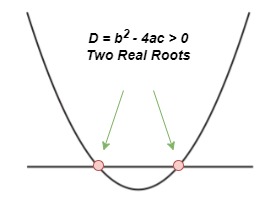
Discriminant case when D > 0, StudySmarter Originals
Case 2: D = 0
When the determinant is equal to zero, or in other words, b2 – 4ac = 0, we obtain one real root. This is also known as a repeated root. The graph for this case is shown below.
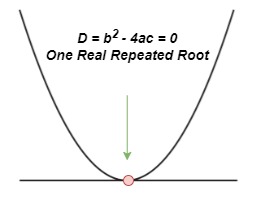
Discriminant case when D = 0, StudySmarter Originals
Case 3: D < 0
When the determinant is less than zero, or in other words, b2 – 4ac < 0, we obtain two complex conjugate roots. This means that our solution is of the form a + bi where a is the real part and b is the imaginary part. The graph for this case is shown below.
 Discriminant case when D < 0, StudySmarter Originals
Discriminant case when D < 0, StudySmarter Originals
Recall that the imaginary unit is
Using the Quadratic Formula and Discriminant to Find Roots
In this section, we shall look at some worked examples that demonstrate the application of the Quadratic Formula and the discriminant to look for solutions to a given quadratic equation.
Two Real Rational Roots
Solve the following quadratic equation.
Calculate the discriminant and identify the number and type of roots this expression holds. Then, use the Quadratic Formula to evaluate its solutions.
Solution
Step 1: Identify a, b and c
Step 2: Calculate the discriminant
As D > 0, there are two real distinct roots.
Step 3: Find the solutions
Using the Quadratic Formula we obtain
Note that the component inside the square root is D, or in other words
Here, is a perfect square so we obtain a pair of rational roots
Thus, the solutions are .
The graph for this quadratic equation is plotted below. The green dots represent the solutions to the expression.
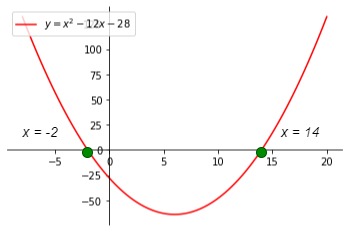
Example 1, StudySmarter Originals
Two Real Irrational Roots
Solve the following quadratic equation.
Calculate the discriminant and identify the number and type of roots this expression holds. Then, use the Quadratic Formula to evaluate their solutions.
Solution
Step 1: Identify a, b and c
Step 2: Calculate the discriminant
As D > 0, there are two real distinct roots.
Step 3: Find the solutions
Using the Quadratic Formula we obtain
Here, is not a perfect square so we obtain a pair of irrational roots
Thus, the solutions are .
The graph for this quadratic equation is plotted below. The green dots represent the solutions to the expression.
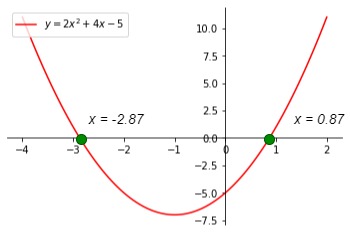
Example 2, StudySmarter Originals
Note that you can keep the roots in the exact form and that the decimal places are an approximate answer.
One Real Repeated Root
Solve the following quadratic equation.
Calculate the discriminant and identify the number and type of roots this expression holds. Then, use the Quadratic Formula to evaluate their solutions.
Solution
Step 1: Identify a, b and c
Step 2: Calculate the discriminant
As D = 0, there is one real distinct root.
Step 3: Find the solutions
Using the Quadratic Formula we obtain
Noting that
Thus, the solution is .
The graph for this quadratic equation is plotted below. The green dots represent the solutions of the expression.
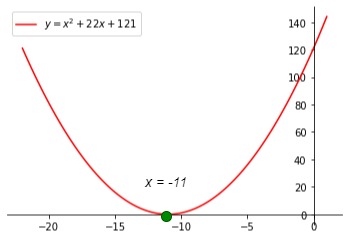
Example 3, StudySmarter Originals
Two Complex Roots
Solve the following quadratic equation.
Calculate the discriminant and identify the number and type of roots this expression holds. Then, use the Quadratic Formula to evaluate their solutions.
Solution
Step 1: Identify a, b and c
Step 2: Calculate the discriminant
As D < 0, there are two complex conjugate roots.
Step 3: Find the solutions
Using the Quadratic Formula we obtain
Noting that
Simplifying this, we obtain
Thus, the solutions are .
The graph for this quadratic equation is plotted below. The green dots represent the solutions to the expression.
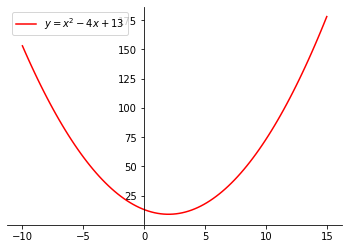
Example 4, StudySmarter Originals
Notice that there are no solutions labelled on this graph. This is because the solutions are imaginary and cannot be graphed in the standard Cartesian plane. The Cartesian plane is represented by real numbers, not imaginary numbers! In this case, we can essentially 'assume' the shape of the graph based on the coefficient of the x2 term and that the y-intercept given by the initial quadratic equation.
Discriminant of a Cubic Equation
In this section, we shall look at the discriminant of a cubic equation and identify the types of roots the expression has, given the value of its discriminant.
For a cubic equation of the (general) form
,
where a ≠ 0, the discriminant is described by the formula
.
The formula for evaluating the discriminant of cubic equations can be quite lengthy. Questions, where this formula may be applied, are often rare in this syllabus. However, it may be helpful to know how it is done for clarity.
Just like the quadratic case, the discriminant for cubic equations has three conditions.
Case 1: D > 0
When the discriminant is more than zero, we obtain three (distinct) real roots.
Say we have the cubic equation .
Here, the discriminant is .
Hence, we have three distinct real roots. Factorizing this expression yields
Thus, the roots are .
The graph is shown below.
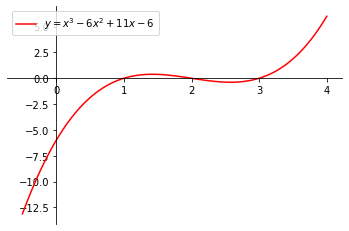
Example 5, StudySmarter Originals
Case 2: D = 0
Case 2(a): If the discriminant is equal to zero and b2 = 3ac, we obtain three repeated real roots (distinct triple root).
Say we have the cubic equation .
Here, the discriminant is .
Further, .
Hence, we have three repeated real roots. Factorizing this expression yields
Thus, the roots are .
The graph is shown below.
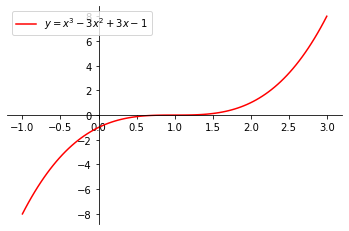
Example 6, StudySmarter Originals
Case 2(b): If the discriminant is equal to zero and b2 ≠ 3ac, we obtain two repeated real roots (distinct double root) and one real (distinct) root.
Say we have the cubic equation .
Here, the discriminant is .
Further, .
Hence, we have two repeated real roots and one real root. Factorizing this expression yields
Thus, the roots are .
The graph is shown below.
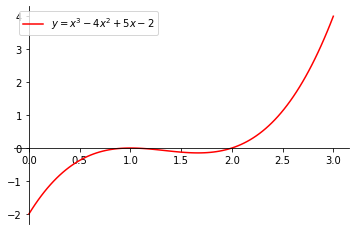
Example 7, StudySmarter Originals
Case 3: D < 0
When the discriminant is less than zero, we obtain one (distinct) real root and a pair of complex conjugate roots.
Say we have the cubic equation .
Here, the discriminant is.
Hence, we have one real root and two complex conjugate roots. Factorizing this expression yields
Thus, the roots are .
The graph is shown below.
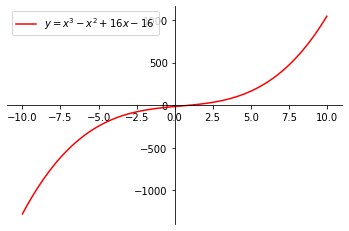
Example 8, StudySmarter Originals
The Quadratic Formula and the Discriminant - Key takeaways
- The Quadratic Formula is used to determine the solutions of a given quadratic equation.
- For a quadratic equation of the form, the Quadratic Formula is
- The Discriminant is used to find the number and type of solutions a quadratic equation has. It is given by the formula D = b2 - 4ac.
- The conditions for the discriminant are summarized in the following table.



















